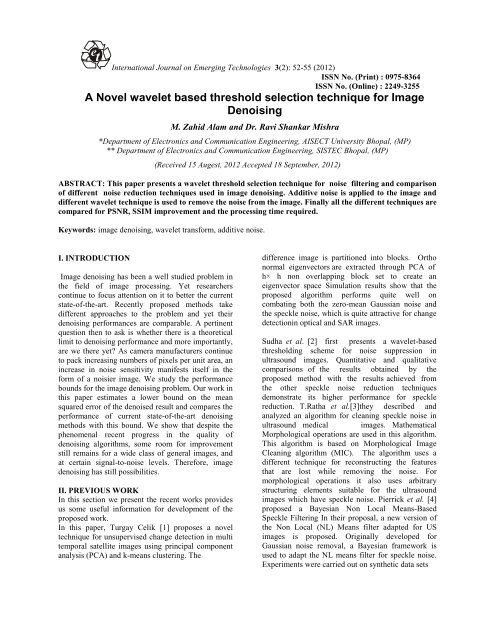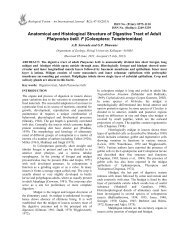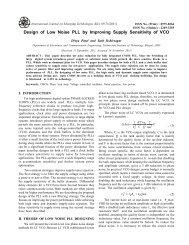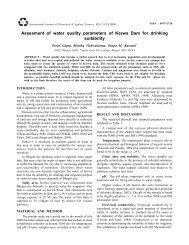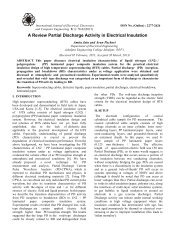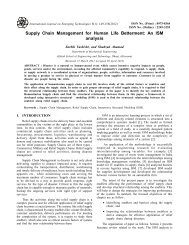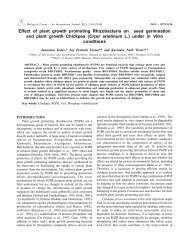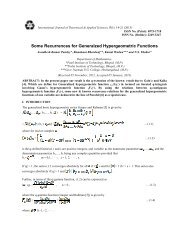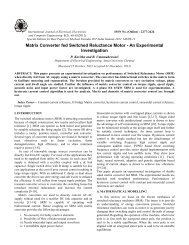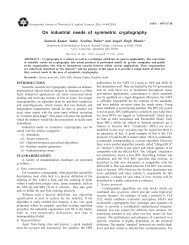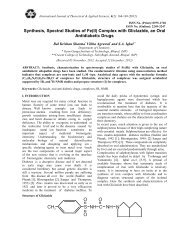A Novel wavelet based threshold selection technique for Image ...
A Novel wavelet based threshold selection technique for Image ...
A Novel wavelet based threshold selection technique for Image ...
You also want an ePaper? Increase the reach of your titles
YUMPU automatically turns print PDFs into web optimized ePapers that Google loves.
e tInternational Journal on Emerging Technologies 3(2): 52-55 (2012)ISSN No. (Print) : 0975-8364ISSN No. (Online) : 2249-3255A <strong>Novel</strong> <strong>wavelet</strong> <strong>based</strong> <strong>threshold</strong> <strong>selection</strong> <strong>technique</strong> <strong>for</strong> <strong>Image</strong>DenoisingM. Zahid Alam and Dr. Ravi Shankar Mishra*Department of Electronics and Communication Engineering, AISECT University Bhopal, (MP)** Department of Electronics and Communication Engineering, SISTEC Bhopal, (MP)(Received 15 Augest, 2012 Accepted 18 September, 2012)ABSTRACT: This paper presents a <strong>wavelet</strong> <strong>threshold</strong> <strong>selection</strong> <strong>technique</strong> <strong>for</strong> noise filtering and comparisonof different noise reduction <strong>technique</strong>s used in image denoising. Additive noise is applied to the image anddifferent <strong>wavelet</strong> <strong>technique</strong> is used to remove the noise from the image. Finally all the different <strong>technique</strong>s arecompared <strong>for</strong> PSNR, SSIM improvement and the processing time required.Keywords: image denoising, <strong>wavelet</strong> trans<strong>for</strong>m, additive noise.I. INTRODUCTION<strong>Image</strong> denoising has been a well studied problem inthe field of image processing. Yet researcherscontinue to focus attention on it to better the currentstate-of-the-art. Recently proposed methods takedifferent approaches to the problem and yet theirdenoising per<strong>for</strong>mances are comparable. A pertinentquestion then to ask is whether there is a theoreticallimit to denoising per<strong>for</strong>mance and more importantly,are we there yet? As camera manufacturers continueto pack increasing numbers of pixels per unit area, anincrease in noise sensitivity manifests itself in the<strong>for</strong>m of a noisier image. We study the per<strong>for</strong>mancebounds <strong>for</strong> the image denoising problem. Our work inthis paper estimates a lower bound on the meansquared error of the denoised result and compares theper<strong>for</strong>mance of current state-of-the-art denoisingmethods with this bound. We show that despite thephenomenal recent progress in the quality ofdenoising algorithms, some room <strong>for</strong> improvementstill remains <strong>for</strong> a wide class of general images, andat certain signal-to-noise levels. There<strong>for</strong>e, imagedenoising has still possibilities.II. PREVIOUS WORKIn this section we present the recent works providesus some useful in<strong>for</strong>mation <strong>for</strong> development of theproposed work.In this paper, Turgay Celik [1] proposes a novel<strong>technique</strong> <strong>for</strong> unsupervised change detection in multitemporal satellite images using principal componentanalysis (PCA) and k-means clustering. Thedifference image is partitioned into blocks. Orthonormal eigenvectors are extracted through PCA ofh× h non overlapping block set to create aneigenvector space Simulation results show that theproposed algorithm per<strong>for</strong>ms quite well oncombating both the zero-mean Gaussian noise andthe speckle noise, which is quite attractive <strong>for</strong> changedetectionin optical and SAR images.Sudha et al. [2] first presents a <strong>wavelet</strong>-<strong>based</strong><strong>threshold</strong>ing scheme <strong>for</strong> noise suppression inultrasound images. Quantitative and qualitativecomparisons of the results obtained by theproposed method with the results achieved fromthe other speckle noise reduction <strong>technique</strong>sdemonstrate its higher per<strong>for</strong>mance <strong>for</strong> specklereduction. T.Ratha et al.[3]they described andanalyzed an algorithm <strong>for</strong> cleaning speckle noise inultrasound medical images. MathematicalMorphological operations are used in this algorithm.This algorithm is <strong>based</strong> on Morphological <strong>Image</strong>Cleaning algorithm (MIC). The algorithm uses adifferent <strong>technique</strong> <strong>for</strong> reconstructing the featuresthat are lost while removing the noise. Formorphological operations it also uses arbitrarystructuring elements suitable <strong>for</strong> the ultrasoundimages which have speckle noise. Pierrick et al. [4]proposed a Bayesian Non Local Means-BasedSpeckle Filtering In their proposal, a new version ofthe Non Local (NL) Means filter adapted <strong>for</strong> USimages is proposed. Originally developed <strong>for</strong>Gaussian noise removal, a Bayesian framework isused to adapt the NL means filter <strong>for</strong> speckle noise.Experiments were carried out on synthetic data sets
Alam and Mishra 53with different speckle simulations. Nonlocal Means-Based Speckle Filtering <strong>for</strong> Ultrasound <strong>Image</strong>s ispresented by [5] In this method, an adaptation of thenonlocal (NL) means filter is proposed <strong>for</strong> specklereduction in ultrasound (US) images. Originallydeveloped <strong>for</strong> additive white Gaussian noise, wepropose to use a Bayesian framework to derive a NLmeansfilter adapted to a relevant ultrasound noisemodel. Quantitative results on synthetic data showthe per<strong>for</strong>mances of the proposed method comparedto well-established and state-of-the-art methods.Results on real images demonstrate that the proposedmethod is able to preserve accurately edges andstructural details of the image. M. I. H. Bhuiya et al.[6] presented Wavelet-Based Despeckling of MedicalUltrasound <strong>Image</strong>s with The Symmetric NormalInverse Gaussian Prior In their proposal, an efficient<strong>wavelet</strong>-<strong>based</strong> method is proposed <strong>for</strong> despecklingmedical ultrasound images. A closed-<strong>for</strong>m Bayesian<strong>wavelet</strong> <strong>based</strong> maximum a posteriori denoiser isdeveloped in a homomorphic framework, <strong>based</strong> onmodeling the <strong>wavelet</strong> coefficients of the logtrans<strong>for</strong>mof the reflectivity with a symmetric normalinverse Gaussian (SNI G) prior. A simple method ispresented <strong>for</strong> obtain-ing the parameters of the SNIGprior using local neighbors. Thus, the proposedmethod is spatially adaptive. Rajan et al. [7] In theirpaper they discuss the speckle reduction in imageswith the recently proposed Wavelet EmbeddedAnisotropic Diffusion (WEAD) and WaveletEmbedded Complex Diffusion (WECD). Both thesemethods are improvements over anisotropic andcomplex diffusion by adding <strong>wavelet</strong> <strong>based</strong> bayesshrink in its second stage. Both WEAD and WECDproduce excellent results when compared with theexisting speckle reduction filters.Normal Inverse Gaussian Prior In their proposal, anefficient <strong>wavelet</strong>-<strong>based</strong> method is proposed <strong>for</strong>despeckling medical ultrasound images. A closed<strong>for</strong>mBayesian <strong>wavelet</strong> <strong>based</strong> maximum a posterioridenoiser is developed in a homomorphic framework,<strong>based</strong> on modeling the <strong>wavelet</strong> coefficients of thelog-trans<strong>for</strong>m of the reflectivity with a symmetricnormal inverse Gaussian (SNIG) prior. A simplemethod is presented <strong>for</strong> obtain-ing the parameters ofthe SNIG prior using local neighbors. Thus, theproposed method is spatially adaptive. Rajan et al. [7]In their paper they discuss the speckle reductionin images with the recently proposed WaveletEmbedded Anisotropic Diffusion (WEAD) andWavelet Embedded Complex Diffusion (WECD).Both these methods are improvements overanisotropic and complex diffusion by adding<strong>wavelet</strong> <strong>based</strong> bayes shrink in its second stage. BothWEAD and WECD produce excellent results whencompared with the existing speckle reduction filters.III. IMAGE FILTRATION TECHNIQUES ANDTRANSFORMSA. Wavelet Trans<strong>for</strong>mA <strong>wavelet</strong> is a wave-like oscillation with amplitudethat starts out at zero, increases, and then decreasesback to zero. It can typically be visualized as a "briefoscillation" like one might see recorded by aseismograph or heart monitor. Generally, <strong>wavelet</strong>sare purposefully crafted to have specific propertiesthat make them useful <strong>for</strong> signal processing.Fig. 1. Simple Wavelet.The <strong>wavelet</strong> trans<strong>for</strong>m replaces the Fouriertrans<strong>for</strong>m's sinusoidal waves by a family generatedby translations and dilations of a window called a<strong>wavelet</strong>. It takes two arguments: time and scale. Adiscrete <strong>wavelet</strong> trans<strong>for</strong>m is any <strong>wavelet</strong> trans<strong>for</strong>m<strong>for</strong> which the <strong>wavelet</strong>s are discretely sampled.B. Wavelet FilteringAfter calculating the DWT coefficient <strong>for</strong>m the DWTtrans<strong>for</strong>m the suppression or elimination ofcoefficients is per<strong>for</strong>med there are many <strong>technique</strong>savailable <strong>for</strong> the <strong>selection</strong> of coefficients andsuppression of coefficients and then the inverse DWTis taken to generate the filtered image.C. Median FilterIn signal processing, it is often desirable to be able toper<strong>for</strong>m some kind of noise reduction on an image orsignal. The median filter is a nonlinear digitalfiltering <strong>technique</strong>, often used to remove noise. Suchnoise reduction is a typical pre-processing step toimprove the results of later processing (<strong>for</strong> example,edge detection on an image). Median filtering is verywidely used in digital image processing because,under certain conditions, it preserves edges whileremoving noise (but see discussion below).The main idea of the median filter is to run throughthe signal entry by entry, replacing each entry with
Alam and Mishra 54the median of neighboring entries. The pattern ofneighbors is called the "window", which slides, entryby entry, over the entire signal. For 1D signals, themost obvious window is just the first few precedingand following entries, whereas <strong>for</strong> 2D (or higher -dimensional) signals such as images, more complexwindow patterns are possible (such as "box" or"cross" patterns). Note that if the window has an oddnumber of entries, then the median is simple todefine: it is just the middle value after all the entriesin the window are sorted numerically. For an evennumber of entries, there is more than one possiblemedian.IV. PROPOSED ALGORITHMThe proposed algorithm works on <strong>wavelet</strong><strong>threshold</strong>ing and the <strong>threshold</strong> is selected byfollowing method.Let the sub band regions of the two-dimensional (2-D) critically sampled <strong>wavelet</strong> trans<strong>for</strong>m. Forconvenience, let us label the sub bands HH k , HL k ,and LH k, where k is the scale, and j is the coarsestscale. The smaller k is, the finer the scale is. Let usalso define sub-band P(S). P(S) is the sub-band of theparents of the coefficients of the sub-band S. Forexample, if S is HH 1 , then P(S) is HH 2 , or if S is HL 2 ,then P(S) is HL 3 .To estimate the noise variance σ 2 n from the noisy<strong>wavelet</strong> coefficients, a robust median estimator isused from the finest scale <strong>wavelet</strong> coefficients (HH 1subband).2/ 0.6745 (׀ y׀) i σ n = MedianWhere y i is element of sub band HH 1 , σ y1 and σ y2can be found by :Using bivariate shrinkage functionEach coefficient is estimated.V. EXPERIMENTAL RESULTSThe algorithms are programmed in MATLAB and thesimulated results <strong>for</strong> PSNR(Peak signal to noiseratio) and SSIM(Structural Similarity) and processingtime, with different noise variance.Table 1: Comparison of various <strong>technique</strong>s (<strong>for</strong>image distorted by noise of variance 0.05, thePSNR and SSIM of noisy image are 30.45dB and32.15% respectively).MethodPSNRTimeSSIM(%)(dB)(Sec.)LEE 32.51 62.81 5.17Median 31.22 61.35 0.147Adaptive 30.02 79.41 2.127Wavelet soft 27.96 41.23 1.18Wavelet hard 26.38 64.26 1.182Table 2: Comparison of various <strong>technique</strong>s (<strong>for</strong>image distorted by noise of variance 0.01, thePSNR and SSIM of noisy image are 37.57dB and63.44% respectively).Where y1 and y2 are Variances of y 1 and y 2 .Using these variances signal variance 1 & 2 canbe estimated by applying <strong>for</strong>mula given as:MethodPSNR(dB)SSIM(%) Time(Sec.)LEE 39.35 83.93 5.19Median 40.55 82.89 0.016Adaptive 41.23 90.18 0.021Waveletsoft33.86 73.35 0.42Wavelethard33.83 85.19 0.128
Alam and Mishra 55VI. CONCLUSIONThe simulation result shows that the <strong>wavelet</strong> domain<strong>technique</strong>s take larger time than the spatial<strong>technique</strong>s and also lags the PSNR and SSIMper<strong>for</strong>mance (it adds the artifacts) at the lower noiselevels but at higher noise level the <strong>wavelet</strong> <strong>technique</strong>outper<strong>for</strong>ms them also the proposed methods willprovide good PSNR value.. In Principal ComponentAnalysis <strong>based</strong> Wavelet <strong>threshold</strong> <strong>technique</strong>, we willtry to enhance per<strong>for</strong>mance of Peak Signal to NoiseRatio by 3-4 dB and Structure Similarity (SSIM)around 70% with lesser Processing time.REFERENCES[1] Turgay Celik , “Unsupervised Change Detectionin Satellite <strong>Image</strong>s Using Principal ComponentAnalysisand k-Means Clustering” IEEE Geoscienceand Remote Sensing Letters, Vol. 6, No. 4, October2009.[2] S. Sudha, G.R Suresh and R. Suknesh,"Speckle Noise Reduction in Ultrasound imagesBy Wavelet Thresholding Based On WeightedVariance", International Journal of ComputerTheory and Engineering, Vol. 1, No. 1, PP 7-12,2009[3] T. Ratha Jeyalakshmi and K. Ramar “A ModifiedMethod <strong>for</strong> Speckle Noise Removal in UltrasoundMedical <strong>Image</strong>s” International Journal of Computerand Electrical Engineering, Vol. 2, No. 1, February,2010 1793-8163.[4] Pierrick Coupe, Pierre Hellier, Charles Kervrannand Christian Barillot “Bayesian Non Local Means-Based Speckle Filtering”, 1291-1294(ISBI 2008).[5] Pierrick Coupe, Pierre Hellier, Charles Kervrann,and Christian Barillot “Nonlocal Means-BasedSpeckle Filtering <strong>for</strong> Ultrasound <strong>Image</strong>s” IEEETransactions On <strong>Image</strong> Processing, Vol. 18, No. 10,October 2009.[6] M.I.H. Bhuiyan, M. Omair Ahmad, Fellow, IEEE,and M.N.S. Swamy “Wavelet-Based Despeckling OfMedical Ultrasound <strong>Image</strong>s With The SymmetricNormal Inverse Gaussian Prior” IEEE I, 721-724(ICASSP 2007).[7] Jeny Rajan and M.R. Kaimal “Speckle Reductionin <strong>Image</strong>s with WEAD and WECD” ICVGIP 2006,LNCS 4338, pp. 184–193, 2006.


